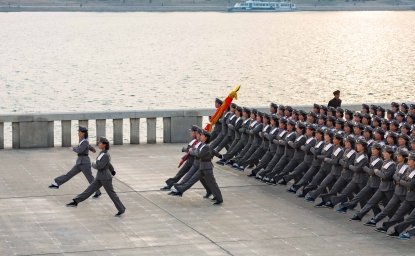Negotiations have resumed in Vienna between Iran and the world’s major powers—Britain, China, France, Germany, Russia and the United States—over bringing Iran back into compliance with the 2015 nuclear agreement (the Joint Comprehensive Plan of Action or JCPOA). This latest effort to break the diplomatic impasse has taken on new urgency after the recent report from the International Atomic Energy Agency that Iran has accelerated its nuclear program and breached the 2015 agreement’s constraints on uranium enrichment. Based on the IAEA’s findings on Iran’s stock of fissile material, independent nuclear experts calculate that Iran could acquire sufficient weapons-grade material to produce a single nuclear bomb in as little as three weeks.
The “all options” formulation, which has been made by successive U.S. administrations, is code for essentially one: the military option.
The structure of a revived deal is evident: Iran’s return to the JCPOA’s constraints on uranium enrichment in return for the lifting of U.S. financial and oil sanctions, as well as an extension of the 2015 agreement’s “sunset” provisions. But it is an open question whether political space exists in Iran to seal a revived deal. If diplomacy fails, and Iran exceeds the 2015 agreement’s constraints on its uranium enrichment program, the Biden administration has declared that "every option is on the table." The “all options” formulation, which has been made by successive U.S. administrations, is code for essentially one: the military option.
There are strikingly few historical cases in which military action was either considered or undertaken to prevent nuclear acquisition. Cases pertinent to the consideration of the military option to constrain Iran’s nuclear ambitions are as follows: U.S. consideration in the early 1960s of a preventive strike on China’s nuclear weapons facilities; Israel’s 1981 bombing of Iraq’s Osirak nuclear reactor; the 1994 North Korean crisis; and Israel’s 2007 bombing of a Syrian nuclear reactor under construction. An understanding of their lessons can inform U.S. policy should diplomacy fail to bridle Iran’s nuclear ambitions. This review does not include the unique case of Iraq in 2003—a preventive war of regime change in which eliminating Iraq’s ability to produce nuclear and other weapons of mass destruction was one of the precipitating rationales.
Nonproliferation Precedents
China (1963-1964)
Declassified documents from the U.S. National Archives indicate that the Kennedy administration seriously explored the feasibility of a preventive military strike on China’s nascent nuclear capability in the early 1960s. The CIA warned that China would be able to test an atomic device during the 1963–65 period—an assessment that precipitated the administration’s exploration of preventive military options. However, U.S. officials were divided: some viewed China as fundamentally more dangerous and irresponsible than the Soviet Union, while others assessed that China could be deterred from aggression by overwhelming U.S. conventional and nuclear superiority; opponents of the military option viewed the Chinese program as motivated primarily by a desire to deter an attack on China itself. After the Kennedy assassination, President Lyndon Johnson, increasingly preoccupied with the escalating conflict in Vietnam, rejected an “unprovoked” preventive strike to prevent China’s acquisition of nuclear weapons.
Iraq (1981)
Israeli prime minister Menachem Begin viewed the prospect of a nuclear-armed Iraq under Saddam Hussein as an existential threat to Israel. On June 7, 1981, a squadron of Israeli jet aircraft surreptitiously traversed Jordanian and Saudi Arabian air space to bomb Iraq’s French-made Osiris-type nuclear reactor near Baghdad. The surprise airstrike was carried out before the reactor was loaded with nuclear fuel and became operational. Though a tactical success, the efficacy of the 1981 air strike is still debated. Proponents declare that the blow to the Iraqi program bought time—not an inconsequential goal in nonproliferation policy. Skeptics counter that the Israeli raid was a strategic failure that did not deter Iraq from acquiring nuclear weapons and may have provided Saddam with further motivation to do so. The stark reality is that a small overt program exponentially expanded into a large covert program after 1981.
Syria (2007)
In spring 2007, the United States was informed by a “foreign intelligence partner,” presumably Israel, that Syria was constructing a nuclear reactor, evidently modeled on the North Korean facility at Yongbyon, capable of producing weapons-grade plutonium. In response, the Bush administration considered either bombing the facility or reporting Syria’s action to the IAEA. When Bush asked the U.S. intelligence community for its assessment, CIA director Michael Hayden reported that the agency had “high confidence” the facility was a nuclear reactor, but only “low confidence” of a weapons program because of the absence of a facility to separate plutonium from the reactor fuel rods. Bush rejected an Israeli request to bomb the facility, telling Prime Minister Ehud Olmert that he could not authorize a strike on a “sovereign nation” without proof that it was a “weapons program.” Bush’s hesitancy on Syria came in the wake of the WMD intelligence fiasco in Iraq. Another factor reportedly underlying the decision was concern that a U.S. attack on Syria could trigger an escalation in Syrian meddling in Iraq, which the United States was desperately attempting to stabilize in the face of a determined Sunni insurgency. Israel bombed the Syrian nuclear facility on September 6, 2007. That it was bombed during the construction phase, before the nuclear core was loaded, reduced the risk of collateral damage to the environment. Syria did not retaliate against Israel for the air strike on a nascent facility whose existence the Damascus regime denied.
North Korea (1994, 2002, 2017)
In 1993-94, the Clinton administration examined the option of military strikes on North Korea’s nuclear infrastructure, an operational 5-megawatt graphite-moderated reactor and a reprocessing facility for spent nuclear fuel at Yongbyon, as that country appeared on the verge of a nuclear breakout. The significant possibility that a preventive attack on the Yongbyon nuclear facilities would have a “catalytic” effect and trigger a general war on the Korean peninsula, which would engulf Seoul given its proximity to the North Korean border. This escalatory concern effectively removed the military option from consideration. In addition, incomplete intelligence gave U.S. policymakers no assurance that air strikes would hit all the pertinent targets at Yongbyon, or that this military action would eliminate the North Korean nuclear threat. In June 1994, a private visit of former President Jimmy Carter to Pyongyang, where he met with the “Great Leader” Kim Il Sung, broke the impasse and led to negotiations that culminated in an “Agreed Framework” to freeze North Korea’s plutonium program by storing and monitoring the reactor’s spent fuel rods at Yongbyon.
In 2002, the revelation of a covert North Korean uranium enrichment program led the Bush administration to abrogate the Agreed Framework. North Korea responded by removing the spent fuel rods and covertly reprocessing them to gain access to plutonium sufficient for approximately six nuclear weapons. The Bush administration pursued a two-pronged strategy to constrain North Korea’s nuclear capabilities: multilateral negotiations (“Six-Party Talks,” which included China) in tandem with targeted economic sanctions. Coercive diplomacy failed to prevent North Korea from crossing the nuclear threshold with a weapons test in October 2006. Beleaguered with two intractable wars of insurgency in Iraq and Afghanistan, the Bush administration did not use force to block North Korea’s acquisition of a nuclear weapon.
Nonetheless, despite a vague North Korean commitment to denuclearization, the three Trump-Kim summit meetings in 2018-2019 failed to bend the curve on North Korea’s nuclear and missile acquisitions.
In 2017, North Korea was on the verge of a strategic breakout through mastery of warhead miniaturization and long-range ballistic missiles) that directly threatened the U.S. homeland. The crisis was further exacerbated by an accelerated tempo of North Korean testing in 2017—23 ballistic missile launches and a high-yield nuclear detonation, which Trump responded to with a threat of “fire and fury.” Then-CIA Director Pompeo declared that “the thing that is most dangerous” about North Korea’s advancing nuclear and missile capabilities is “the character who holds the control over them today.” After his surprise Singapore summit in June 2018 with Kim Jong-Un, Trump declared the war scare over, tweeting “there is no longer a Nuclear Threat from North Korea.” Nonetheless, despite a vague North Korean commitment to denuclearization, the three Trump-Kim summit meetings in 2018-2019 failed to bend the curve on North Korea’s nuclear and missile acquisitions.
Policy Implications
Proponents of the military option to forestall proliferation often cite the Israeli raid on Iraq’s nuclear reactor as a model. But the Osirak case, far from being a paradigm, was a rare instance in which the major conditions for success were all present: specific and highly accurate intelligence about the target, and the negligible risk of retaliation or collateral damage to the environment and civilian population. To the extent there is another case that conformed to the Osirak model, it was the Israeli air strike on the nascent Syrian nuclear reactor.
The United States ultimately abstained from preventive military action against both China in the early 1960s and North Korea across several crises from 1994 to 2017 because of the overriding escalatory risks. In both cases, what drove initial consideration was the perception that these proliferators’ threats derived not from the acquisition of nuclear capabilities per se, but, more fundamentally, from the character of their regimes. Mao’s post-revolutionary China was viewed as the Cold War era’s functional equivalent of a rogue state. North Korea was a charter member of the post-Cold War rogues gallery, whose other members (Iraq and Iran) constituted an “axis of evil.”
North Korea is the counter paradigm to Osirak in which essentially none of the conditions for successful military prevention were present. Throughout multiple crises with North Korea, these major constraints led successive U.S. administrations to eschew the use of force. The Trump-Kim summit meetings did not limit North Korean capabilities but did change the psychology of the crisis, thereby deferring the military option through what one analyst characterized as “the normalization of Kim Jong-Un and North Korea.”
With Iran, the character of the regime has been central to the debate over the definition of threat—and U.S. policy options. A significant, but unremarked, conclusion of the 2007 National Intelligence Estimate on Iran’s nuclear intentions and capabilities (which the Bush administration took the unprecedented step of making public) was the finding that “Tehran’s decisions are guided by a cost-benefit approach rather than a rush to a weapon irrespective of the political, economic, and military costs.” This analysis, supporting the conclusion that regime survival has been the clerics’ paramount goal, was contrary to the alternative depiction of Iran as an undeterrable, apocalyptic, irrational, “rogue” state.
A nuclear hedge is Iran’s strategic sweet spot—maintaining the potential for a nuclear option, while avoiding the regional and international repercussions of actual weaponization.
A diplomatic breakdown would not invariably lead to an Iranian breakout to a bomb. The U.S. intelligence community continues to assess that the Tehran leadership has not yet made a strategic decision to acquire nuclear weapons. Iran’s ability to enrich uranium inherently provides Iran with a hedge for a weapon. A nuclear hedge is Iran’s strategic sweet spot—maintaining the potential for a nuclear option, while avoiding the regional and international repercussions of actual weaponization.
Iran has now exceeded the JCPOA’s constraints and enriched uranium to 60%, just shy of the 90% required for a weapon. Iran’s hedge is now less hedged. This is the urgent dilemma confronting the Biden administration: On one hand, the longstanding goal of U.S. policy has been to prevent Iran from obtaining a nuclear weapon. On the other, by drawing this red line—preventing weaponization—successive U.S. administrations essentially signaled that the United States would not undertake preventive military action to deny Iran any nuclear hedge option.
So far as Iranian progress falls short of overt weaponization, the U.S. administration would be hard pressed to sustain the case for implementing the military option. After Iraq, when flawed intelligence on Saddam Hussein’s WMD programs was central to the Bush administration’s case for preventive war, the United States would simply not get the benefit of the doubt. And doubt there would be in the absence of hard evidence of weaponization. That the U.S. red line on weaponization pushes off a decision on the use of force is also a reflection of how unattractive the option would be—and the historical record of cases involving the consideration or use of force against an adversarial proliferator supports that conclusion.
If diplomacy fails to constrain Iranian capabilities, the United States and Israel would likely redouble their cyberattacks (e.g., Stuxnet) and covert intelligence operations to disrupt Iran’s nuclear program. But such efforts—which along with punitive economic sanctions are pillars of a containment strategy—can only go so far. Invariably, the collapse of the JCPOA would revive discussion of the military option—the possibility of American airstrikes on Iran’s nuclear infrastructure.
The openly-debated military option—what would be the most telegraphed punch in history—runs up against four major liabilities.
First, military action would only set back the program for several years, not end it. Having mastered the uranium enrichment process to acquire the requisite material for a weapon, the program could be reconstituted. In 2011, Secretary of Defense Leon Panetta estimated that an attack would only delay the Iranian program by three years. Proponents of the military option minimize this consideration, likening attacks on Iran’s nuclear infrastructure to “mowing the grass,” which can be periodically repeated as Iran reconstitutes its capabilities. But that radical proposal does not address the other major liabilities of the military option.
Even a “limited” attack on Iran’s nuclear sites would escalate across the region and beyond—or, at least, no U.S. President could discount that possibility.
Second, more fundamentally, in Tehran, military action could be viewed as the initiation of a regime-toppling war. The envisioned scope of U.S. military action would reinforce that Iranian perception: an air campaign would likely encompass a range of military targets (such as air defense and command-and-control facilities) beyond the nuclear infrastructure. Given the size and geographical distribution of Iran’s nuclear infrastructure, such a mission would likely span several days rather than a single mission like Israel’s lightning air strike on Iraq’s Osirak reactor in 1981. Moreover, Iran’s Supreme Leader Khamenei has warned that U.S. military action would lead to Iranian retaliation against U.S. interests worldwide. Even a “limited” attack on Iran’s nuclear sites would escalate across the region and beyond—or, at least, no U.S. President could discount that possibility. Iran’s advanced missile program provides a potent escalatory option. General Kenneth McKenzie, USMC, who heads U.S. military operations across the Middle East and South Asia, recently warned, “Iran’s strategic capacity is now enormous.” Consider the stunning September 2019 episode in which Iran, responding to the U.S. “maximum pressure” campaign to deny it the ability to export oil, launched 20 drones and precision-guided cruise missiles at Saudi Arabian oil fields and processing centers, cutting Saudi oil production in half.
Third, an American attack, which would be viewed within Iran as an act of war, could well generate a nationalist backlash with the perverse consequence of bolstering the clerical regime.
Fourth, notwithstanding claims about the ability of U.S. bunker-busters to surgically collapse hardened targets, military strikes on “hot” sites containing toxic fissile material (e.g., uranium hexafluoride, enriched uranium, etc.) could have disastrous environmental consequences. The proximity of Iranian sites to population centers poses a potential radiological risk to thousands of civilians.
Conclusion
Put baldly, the United States has three options to address Iran’s nuclear challenge: negotiate, bomb, or deter.
Diplomacy may still yield an agreement to bring Iran back into compliance with the JCPOA’s constraints on its nuclear program. For the Tehran leadership, the prospect of sanctions relief for Iran’s hard-pressed economy provides motivation to reach a JCPOA 2.0, especially as, from a national security perspective, Iran faces no existential threat necessitating an urgent dash to the bomb. Moreover, up to now, the strategic ambiguity of a hedge has well served Iranian interests—and a revived JCPOA would permit Iran to retain that hedge.
If diplomacy fails, the military option—striking Iran’s nuclear infrastructure—would be no Osirak. The major constraints on the use of force against Iran are analogous to those that resulted in U.S. restraint through multiple crises with North Korea.
Given the diplomatic and military constraints, U.S. policymakers could be left with the third option—America’s traditional default strategy toward adversarial states: containment and deterrence. To be sure, that strategy would be making the best of a bad situation, but containment and deterrence has been employed in other hard cases—Stalin’s Soviet Union, Mao’s China, and the Kim family’s North Korea. Proponents of the military option are arguing that Iran has a uniquely dangerous and irrational regime that would make it the sole exception of the nuclear age. With Iran, an updated version of George F. Kennan’s strategy would decouple the nuclear issue from the question of regime change and rely on containment and deterrence to check Iran’s nuclear capabilities and regional actions.
The views expressed in this article are personal to the author and do not represent those of the Wilson Center, which does not take positions on policy issues.
Author


Middle East Program
The Wilson Center’s Middle East Program serves as a crucial resource for the policymaking community and beyond, providing analyses and research that helps inform US foreign policymaking, stimulates public debate, and expands knowledge about issues in the wider Middle East and North Africa (MENA) region. Read more


History and Public Policy Program
A leader in making key foreign policy records accessible and fostering informed scholarship, analysis, and discussion on international affairs, past and present. Read more

Explore More
Browse Insights & Analysis
US Inaction Is Ceding the Global Nuclear Market to China and Russia

Civil Society and Nuclear Risk Reduction


